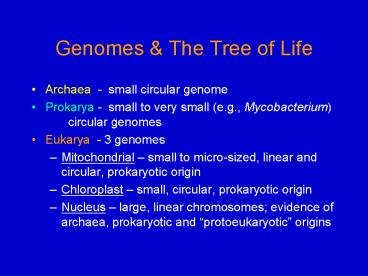Genomes - PowerPoint PPT Presentation
Title:
Genomes
Description:
... genetic complexity of plants. yeast Drosophila Arabidopsis No. of genes 6200 13,600 25,000 No. of gene families 4380 8065 11,000 No. of genes from duplication ... – PowerPoint PPT presentation
Number of Views:35
Avg rating:3.0/5.0
Title: Genomes
1
Genomes The Tree of Life
- Archaea - small circular genome
- Prokarya - small to very small (e.g.,
Mycobacterium) circular genomes - Eukarya - 3 genomes
- Mitochondrial small to micro-sized, linear and
circular, prokaryotic origin - Chloroplast small, circular, prokaryotic origin
- Nucleus large, linear chromosomes evidence of
archaea, prokaryotic and protoeukaryotic origins
2
Chloroplast DNA in Green Plants
- Circular, multi-copy (20-100/organelle)
- 160,000 bp 125 genes
- Most genes of two types
- Photosynthesis
- Genetic functions (mostly translation)
3
Tobacco (Nicotiana tabacum) chloroplast genome
From Kloppstech, Westhof et al.
4
Plant nuclear genome sizes are large and widely
varied.
x 1000 to get bp
Lilium longiflorum (Easter lily) 90,000
Mb Fritillaria assyriaca (butterfly) 124,900
Mb Protopterus aethiopicus (lungfish) 139,000
Mb
5
What about genetic complexity?
- How many genes do organisms have?
6
Organism Taxon Genes
Mycoplasma prokaryote 517
E. coli prokaryote 4300
Archaeoglobus archaeon 2500
Cyanidioschyzon rhodophyte 4700
Saccharomyces yeast 6000
Drosophila insect 13,600
Chlamydomonas chlorophyte (unicell) 15,500
Arabidopsis angiosperm, dicot 25,000
Homo sapiens primate 32,000
Oryza (rice) angiosperm, monocot 32-39,000
Texas wild rice
7
Mycoplasma How many genes essential for growth
(under lab conditions)?
- Using transposon mutagenesis, 150 of the 517
genes could be knocked out 300 genes deemed
essential (under lab conditions), which included - 100 of unknown function
- Genes for glycolysis ATP synthesis
- ABC transporters
- Genes for DNA replication, transcription and
translation
Science 286, 2165 (1999)
8
Genomic and species differences contributing to
the wide range of nuclear genome sizes
- There can be great variation in the
- Fraction of highly repeated DNA
- Abundance of "Selfish DNA
(transposons, etc.) - Frequency and sizes of introns
- Humans have many larger introns
- Genetic redundancy
9
Genetic Redundancy
- The sizes of many gene families has increased in
some organisms more than others - Accounts at least partially for the relatively
high genetic complexity of plants.
10
Genetic Redundancy or Duplication
yeast
Drosophila
Arabidopsis
No. of genes 6200 13,600 25,000
No. of gene families 4380 8065 11,000
No. of genes from duplication 1820 5535 14,000
11
Impact of Horizontal Transfer on Genomes
- 20 of the E. coli genome was obtained by
lateral transfer. - Viral and bacterial pathogens can transfer DNA
from host to host. - Some nuclear genes came from organellar genomes
(some relatively recently). - Selfish DNAs such as mobile introns and
transposons occasionally transfer horizontally.
12
What can you do with whole genomes sequences?
- Predict much about the functions of a poorly
studied or difficult organism - - only 1-5 of bacteria in the environment are
culturable
13
Transport and metabolic pathways of the Lyme
disease spirochaete, Borrelia predicted from the
genome sequence.
Nature 390, 583
14
What can you do with whole genomes sequences?
- Predict much about the functions of a poorly
studied or difficult organism. - Can examine genome-wide expression patterns with
microarrays (e.g., cancer versus normal cells).
15
Can immobilize 1,000-5,000 DNAs (genes) on one
microarray glass slide.
1. Hybridize slide to cDNAs that were obtained by
reverse transcription from total mRNAs with a
fluorescent nucleotide. 2. Scan slide with a
laser and process fluorescent image.
Can simultaneously compare 2 different mRNA
preparations by using different colored
fluorescent nucleotides.
Red- induced mRNA Green- decreased mRNA Yellow
unchanged mRNA
16
What can you do with whole genome sequences?
- Predict much about the functions of a poorly
studied or difficult organism. - Can examine genome-wide expression patterns with
microarrays (e.g., cancer v. normal cells). - Identify new drug targets.
- More rapidly identify genes linked to a trait.
- Rapidly identify a gene for an identified protein
by mass spectrometry compare mass spectrum of
the protein with the predicted patterns from all
of the genes of a sequenced genome (Proteomics).































